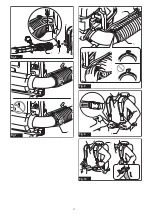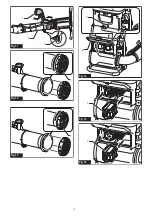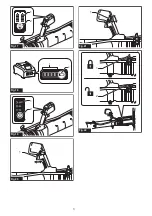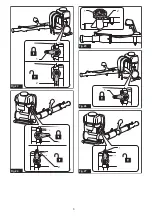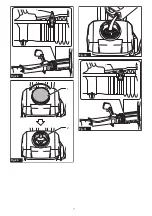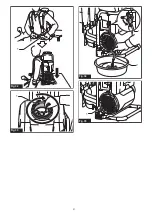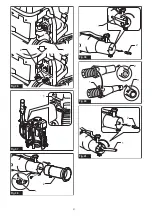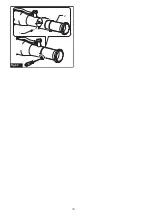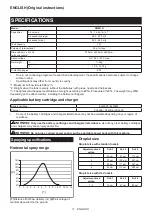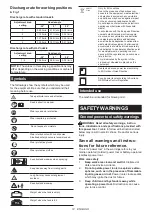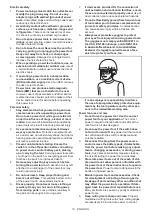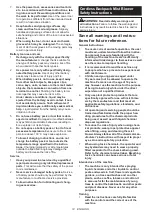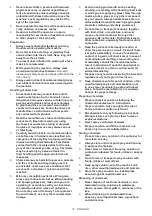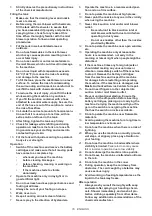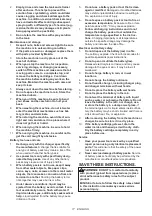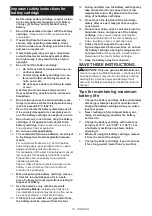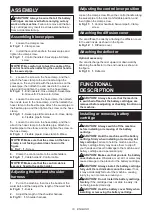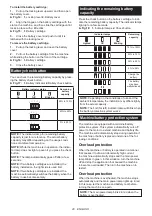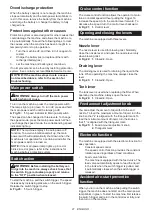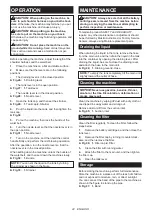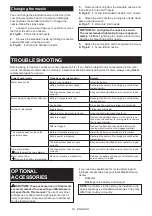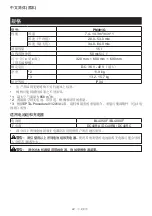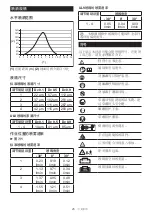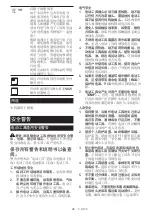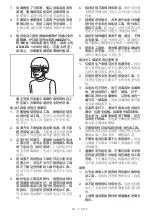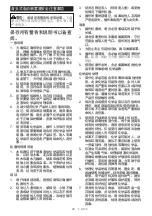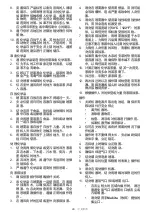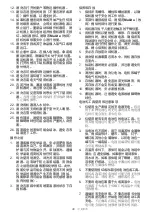
15 ENGLISH
2.
Never allow children, persons with reduced
physical, sensory or mental capabilities or
lack of experience and knowledge or people
unfamiliar with these instructions to use the
machine. Local regulations may restrict the
age of the operator.
3.
Never operate the machine while people, espe-
cially children, or pets are nearby.
4.
Keep in mind that the operator or user is
responsible for accidents or hazards occurring
to other people or their property.
Preparation
1.
Always wear substantial footwear and long
trousers while operating the machine.
2.
Do not wear loose clothing or jewellery that
can be drawn into the air inlet. Keep long hair
away from the air inlets.
3.
To prevent dust irritation the wearing of a face
mask is recommended.
4.
While operating the machine, always wear
non-slip and protective footwear.
Non-skid,
closed-toed safety boots and shoes will reduce the
risk of injury.
5.
Always wear rubber/chemical-resistant gloves
and rubber/chemical boots when working with
the machine.
Handling of chemicals
1.
Some chemicals may contain toxic and/or
caustic substances. Such chemicals can be
dangerous and cause serious or fatal injury to
persons and animals and/or severe damage
to plants and the environment. Avoid direct
contact with chemicals. Follow the chemical
manufacturer’s instructions with respect to
any contact with its product.
2.
Read the manufacturer’s label and instruction
manual each time before mixing or using
the chemical and before storing or disposal.
Careless or improper use may cause serious
or fatal injury.
3.
Carefully read the labels on chemical contain-
ers before use. Chemicals are classified into
categories of toxicity. Each category will have
unique handling characteristics. Familiarize
yourself with the characteristics for the cate-
gory of the chemical you are using. Chemicals
may be used only by persons trained in
their handling and the appropriate first-aid
measures.
4.
Chemicals may be harmful to persons, animals
and the environment if improperly used. It
is advisable not to use some chemicals that
are caustic, corrosive or poisonous with the
machine.
5.
Mix only compatible pesticides. Wrong mix-
tures can produce toxic fumes. When handling
and spraying chemicals, make sure you are
operating in accordance with your local envi-
ronmental protection rules and guidelines.
Do not spray when it is windy. To help protect
the environment, use only the recommended
dosage.
6.
Avoid opening your mouth such as eating,
drinking, or smoking while handling chemicals
or while you are spraying. Never blow through
nozzles, tubes, pipes or any other component
by your mouth. Always handle chemicals in a
well-ventilated area while wearing appropriate
protective clothing and safety equipment.
7.
Do not store or transport chemicals together
with food, drink, or medicines, and never
reuse a chemical container for any other
purposes. Do not transfer liquid chemicals to
other containers, especially food and/or drink
containers.
8.
Keep the product’s label ready to read to or
show the persons you consult. Clean all chem-
ical spills immediately. In case of accidental
contact or ingestion of chemicals or in case of
contamination of clothing, stop working and
immediately consult the chemical manufac-
turer’s instructions. If doubtful about what to
do, ask a doctor or poison control center for
advice immediately.
9.
Dispose of any residue observing the laws and
regulations of your region of residence.
10.
Keep chemicals out of reach of children, other
unauthorized people and animals. When not
in use, store chemicals in a safe and locked
place. Follow the manufacturer’s recommen
-
dations for proper storage.
Preparing chemicals
1.
Prepare chemical solutions following the
chemical manufacturer’s instructions.
2.
Prepare solution only enough for the job at
hand so that no solution is left over.
3.
Mix chemicals only by following instructions.
Wrong mixtures can produce toxic fumes or
explosive mixtures.
4.
Never spray undiluted chemicals.
5.
Prepare solution and fill the container out
-
doors only in a well-ventilated place.
Storing chemicals
1.
Do not store spray solution in the container for
more than one day.
2.
Always store and transport spray solution only
in approved containers.
3.
Never store or transport the spray solution in
containers intended for foods, drinks or animal
feed.
4.
Do not store or transport spray solution with
foods, drinks or animal feed.
5.
Keep spray solution out of the reach of chil-
dren, other unauthorized people and animals.
6.
Store the spray solution in a locked place
secured against unauthorized use.
Disposing of chemicals
1.
Never dispose of residual chemicals or con-
taminated rinsing solutions in waterways,
drains, sewers, street gutters, manholes or the
like.
2.
When disposing of contaminated rinse,
observe your all applicable laws, regulations
and ordinances.
Summary of Contents for PM001G
Page 2: ...2 0 30 30 Fig 1 1 Fig 2 1 2 3 Fig 3 6 1 2 3 4 5 Fig 4 2 1 4 3 5 Fig 5 ...
Page 3: ...3 3 2 1 Fig 6 1 Fig 7 1 2 Fig 8 1 Fig 9 1 Fig 10 ...
Page 4: ...4 1 2 3 Fig 11 1 Fig 12 1 Fig 13 1 2 Fig 14 1 Fig 15 1 Fig 16 ...
Page 5: ...5 1 2 Fig 17 1 2 Fig 18 1 2 Fig 19 1 Fig 20 1 Fig 21 1 2 Fig 22 ...
Page 6: ...6 1 2 Fig 23 1 2 Fig 24 2 1 Fig 25 1 Fig 26 1 Fig 27 ...
Page 7: ...7 1 Fig 28 1 2 Fig 29 Fig 30 1 Fig 31 ...
Page 8: ...8 1 Fig 32 1 Fig 33 1 2 Fig 34 1 Fig 35 ...
Page 9: ...9 2 1 Fig 36 1 Fig 37 1 2 Fig 38 1 2 Fig 39 1 2 3 Fig 40 1 2 Fig 41 ...
Page 10: ...10 1 2 Fig 42 ...
Page 99: ...99 ...



